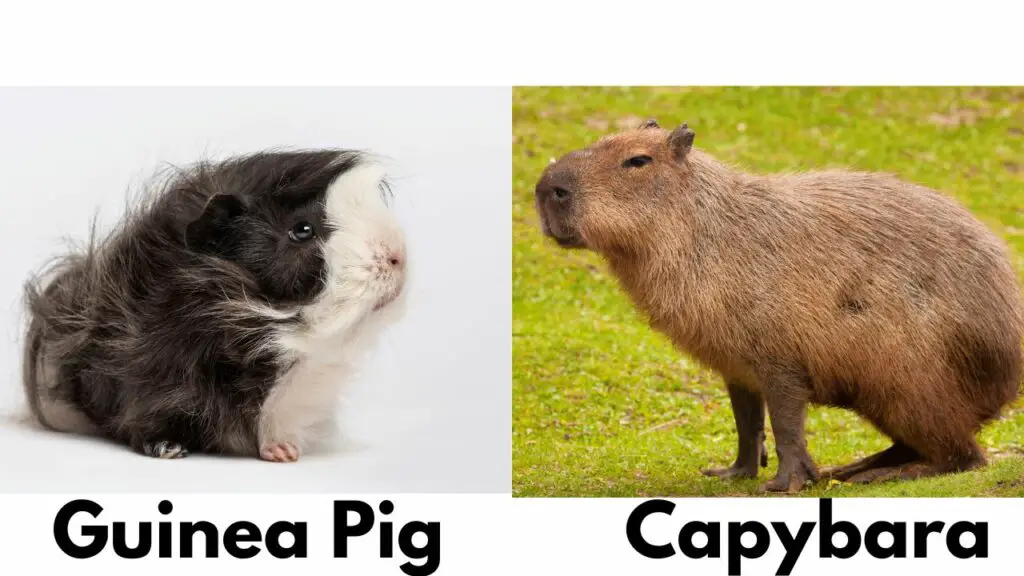If you are an animal lover, you might have come across two small furry animals, guinea pigs and capybaras.
Although these two animals may look alike at first glance, they are quite different from each other in many ways. However, they do share a common ancestry, which makes them both members of the cavy family.
In this blog post, we will explore the connection between guinea pigs and capybaras and delve into their similarities and differences.

What are guinea pigs and capybaras?
Guinea pigs: A Brief Introduction
Guinea pigs, also known as cavy, are small, herbivorous rodents native to the Andes Mountains in South America. They have been domesticated for thousands of years and are popular pets around the world.
Guinea pigs are social animals and thrive on companionship. They are also known for their unique vocalizations, which are used to communicate with each other and their human caretakers.
Introduction to Capybaras
Capybaras, on the other hand, are the largest rodents in the world. They are native to South America and are commonly found near bodies of water such as rivers, lakes, and swamps.
Capybaras are social animals and often form herds consisting of up to twenty individuals. They are also known for their docile nature and are sometimes kept as pets in some parts of the world.
Similarities and Differences Between Guinea Pigs and Capybaras
Anatomy and Physical Characteristics
Guinea pigs and capybaras share some physical characteristics. For instance, both animals have four toes on their front feet and three toes on their hind feet.
Additionally, they both have long, curved front teeth that are used for gnawing on plants. However, the similarities end there.
Guinea pigs are much smaller than capybaras, with an average weight of around 1-2 pounds, while capybaras can weigh up to 140 pounds.
Habitat and Natural Environment
Guinea pigs are commonly kept as pets in households worldwide, while capybaras are found in the wild in South America.
Guinea pigs are kept in cages or pens and require a diet consisting of hay, fresh vegetables, and water. Capybaras, on the other hand, live in the wild in groups and feed on a variety of plants and grasses.
Diet and Feeding Habits
As mentioned, guinea pigs require a specific diet consisting of hay, fresh vegetables, and water. They are unable to synthesize vitamin C and therefore require supplementation to remain healthy.
Capybaras, on the other hand, are able to synthesize vitamin C, and their diet consists mainly of grasses and aquatic plants. They also require a lot of water and are often found near rivers or bodies of water.
Behavior and Social Structure
Both guinea pigs and capybaras are social animals and thrive on companionship. Guinea pigs are kept in pairs or groups as pets, while capybara herds can consist of up to twenty individuals.
Capybaras are known for their docile nature and have been observed interacting with other animals, such as birds and monkeys, in the wild.
Evolutionary Relationship Between Guinea Pigs and Capybaras
Cavy Family Tree: How Guinea Pigs and Capybaras are Related
Guinea pigs and capybaras are both members of the cavy family, which includes over 20 different species of rodents.
The cavy family is believed to have originated in South America over 40 million years ago. Guinea pigs and capybaras share a common ancestry and are believed to have diverged from a common ancestor around 10 million years ago.
Genetic Analysis and Research Findings
Genetic analysis has revealed that guinea pigs and capybaras share a high degree of genetic similarity, with over 90% of their DNA being identical. This suggests that they are closely related and have a common ancestry.
Roles of Guinea Pigs and Capybaras in Human Society
Domestication and Use as Pets
Guinea pigs are one of the oldest domesticated animals and have been kept as pets for thousands of years. They are popular pets worldwide due to their docile nature and social behavior.
Capybaras, on the other hand, are not commonly kept as pets due to their size and specific needs. They are sometimes kept in zoos and wildlife parks for educational purposes.
Cultural Significance and Traditional Uses
Guinea pigs have cultural significance in South America, where they are often used as a source of food. They are also used in traditional medicine to treat various ailments. Capybaras are also used as a source of food in some parts of South America.
Conservation Efforts and Threats to the Species
Both guinea pigs and capybaras are not considered endangered species. However, capybaras are threatened by habitat loss due to deforestation and human encroachment. Conservation efforts are underway to protect their natural habitats and ensure their survival in the wild.
Conclusion
In conclusion, guinea pigs and capybaras are both members of the cavy family and share a common ancestry. Although they share some physical characteristics and social behaviors, they are quite different from each other in many ways, from their size and diet to their habitat and natural environment.
Further research on the genetic relationship between guinea pigs and capybaras may shed light on the evolution of the cavy family and their adaptation to different environments. Understanding the connection between these two animals can also help us appreciate the diversity of life on our planet and the complex relationships between different species.
- How Long Do American Eskimo Dogs Live? Important Factors and Care Tips - September 29, 2023
- Do American Bulldogs Need Grooming? Essential Tips and Care Guidelines - September 29, 2023
- Do Bengal Cats Enjoy Playing? Essential Tips for Keeping Them Active - September 29, 2023